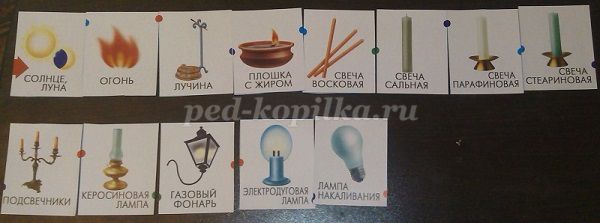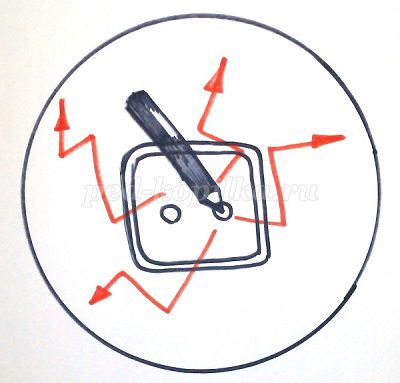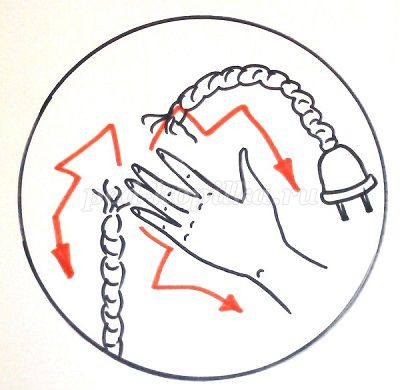Scenario of a cognitive journey-acquaintance "Electricity and electrical appliances" for kindergarten
Cognitive journey-acquaintance "Electricity and electrical appliances"
Cognitive journey scenario
Krivyakova Elena Yurievna, teacher of speech therapy group, MBDOU child development center - kindergarten No. 315 in ChelyabinskDescription:
We would like to draw your attention to the scenario of a cognitive journey. Section "Child and the World". The scenario of a cognitive journey is aimed at expanding and generalizing knowledge about electricity and electrical appliances, fostering safe behavior in relation to electricity and electrical appliances, interest in objects around in everyday life, and using the knowledge gained in play. The prepared material will be useful for teachers of additional education, teachers of speech therapy and general education groups.
Integration of educational areas:"Cognition", "Communication", "Security", "Socialization".
Types of children's activities: play, cognitive, communicative, experimental.
Target: Development of interest in phenomena and objects in the surrounding world. Expanding knowledge of safe behavior.
Tasks
Educational:
1. Expand knowledge about electricity and electrical appliances.
2. To generalize the knowledge of children about the benefits and dangers of electricity.
3. To replenish the children's dictionary with new concepts of "hydroelectric power station", "battery", "electric current".
Correctional and developmental:
4. To intensify the speech and mental activity of children. Promote the ability to clearly and competently formulate your thought.
5. To automate sound pronunciation in children during onomatopoeia.
6. To develop visual and auditory attention, verbal and logical thinking, memory, creative imagination.
7. Develop social and communication skills of children in joint activities.
Educational:
8. To cultivate a benevolent attitude towards peers through the ability to listen to a friend and accept the opinion of another.
9. To educate basic skills of safe behavior in everyday life when handling electricity.
Expected Result: increasing interest in surrounding objects in everyday life and using the knowledge gained in everyday life.
Preliminary work: conversation "A journey into the past of a light bulb"; memorizing riddles and poems about electrical appliances; viewing illustrations depicting electrical appliances; selection of items powered by batteries, accumulators, batteries for the exhibition; stories of children from personal experience.
Equipment:
- a cutaway picture with an image of an electric light bulb;
- cards from the didactic game "Evolution of transport and things around us" on the example of a group of "lighting devices";
- candle;
- multimedia system;
- a toy set for conducting experiments in different fields of knowledge "Electric siren" from the series of scientific toys "Exploring the World";
- exhibition of items powered by batteries, accumulators, batteries;
- easel;
- soft modules;
- models depicting safety rules when working with electrical appliances;
- emblems with the image of a light bulb according to the number of children.
Teaching and education methods: literary word (poems and riddles), demonstration material, the use of elements of TRIZ technology (techniques: "good - bad", modeling), experimentation.
Carrying out conditions: a spacious hall in which you can move freely; high chairs by the number of children; the table on which the exhibition is located; easel with upside-down models for safe handling of electrical appliances.
Event progress:
Introductory speech of the educator (stimulation for upcoming activities):
Dear Guys! I am glad to see you all healthy and cheerful. Today we will have an unusual journey, in which we will learn a lot of interesting things. And to begin with ...
Problematic situation: notice what is on the table? It looks like these are cut parts of the picture. Take each piece one at a time, try to put together the overall picture (children collect).
What happened? (electric lamp).
Educator: Tell me, have people always used light bulbs for lighting? (children's answers).
Diving into the problem: I suggest you plunge into the past and trace how people illuminated their homes at different times.
Didactic game "Evolution of things around us"

Exercise: Before you are pictures of different lighting fixtures. Choose a picture that caught your attention, you liked. And now, with their help, we will build a path from the past to the present. (Arrange the cards in chronological order, in accordance with the earlier conversation: "Traveling into the past of an electric light bulb").
Educator: We have built a bridge from the past to the present. I'll take a candle now, light it, and you follow me (the child who goes last collects pictures)... We pass along the “bridge” from the past to the “present”.
Educator: Here we are with you and were in the present (the teacher invites the children to sit on the chairs in front of the screen).
Poem riddle:
I see a socket up on the wall
And it becomes interesting to me
(Electricity)
Educator: Do you want to know how electricity comes to our house?
Slide show

The teacher comments: This is a hydroelectric power plant. Under high pressure, water enters the turbine, where electricity is generated with the help of a generator. It is fed to special substations, and from them then runs through wires to our homes, hospitals, factories and where people cannot do without electricity.
Educator: Tell me, what else do people use electricity for, besides lighting a room? (estimated children's answer: to use electrical appliances).
Game "Riddles-Clues"
Children take turns asking riddles. After the children answer, the correct answer appears on the multimedia screen.
1st child:
If I see dust, I grumble
I'll wrap it up and swallow it! (Vacuum cleaner)
Educator: What sounds can we hear when the vacuum cleaner is running? (J)
2nd child:
First load the laundry into it,
Pour the powder and plug it in
Do not forget to set the washing program,
And then you can go to rest. (Washer)
Educator: What sounds do we hear when the washing machine is running? (RU).
3rd child:
Is your dress wrinkled? Nothing!
I'll smooth it out now,
It's no stranger to working for me ...
Ready! Can be worn. (Iron)
Educator: What sounds can we hear when the iron is running? (PSh).
4th child:
Different products live there,
Cutlets, vegetables and fruits.
Sour cream, cream and sausages,
Sausages, milk and meat. (Fridge)
Educator: Well done, we have not only solved all the riddles, but also remembered all the sounds that we hear when these electrical appliances work.
I wonder what sounds do we hear when the refrigerator is running? (answer DZ).
Guys, remember what electrical appliances we have not yet named, name them. (Children's responses are accompanied by a slide show)... Remember everyone ?!
Physical education (activation of attention and physical activity, restoration of working capacity).
Educator: Where is the refrigerator usually in the apartment? (on the kitchen)
And you and I will pretend that we are in the kitchen (children perform movements in accordance with the text).
What is the noise in this kitchen?
We will fry the cutlets.
We'll take the meat grinder
Let's turn the meat quickly.
Beat together with a mixer
Everything we need for the cream.
To bake a cake as soon as possible
We will turn on the electric furnace.
Electrical appliances are a miracle!
It would be bad for us to live without them.
Educator: Do you know, guys, that people have learned how to tame electricity, and even hide it in special "houses": accumulators and batteries - they are called "batteries" (Show pictures on a slide).
Experiment (specially prepared table)... We will now conduct an experiment with you and check: is it true that the electrical system can operate on ordinary batteries. And make sure that electricity really "lives" in them (Experience with the "electric siren" set).

Educator: Guys, who knows where else people use these "houses" to store electricity: batteries, accumulators? (Answers: video camera, flashlights, control panel, camera). The teacher draws the attention of children to the exhibition, examines the exhibits.
Educator: Guys, think and tell me, what benefits does electricity bring to a person? (children's answers).
- Is there any harm? (children's answers).
Safe handling when working with electrical appliances
Children sit on soft modules opposite the easel.
Exercise: Using the models, we need to formulate the basic safety rules when working with electrical appliances. We formulate rules for showing models.

Rule 1. Do not insert foreign objects, especially metal, into the electrical outlet!
Why? Because the current, like on the bridge, will cross over the object on you and can greatly damage your health.

Rule 2. Do not touch bare wires with your hands!
Why? An electric current flows through the bare, not protected by the winding wire, the shock of which can be fatal.
![]()
Rule 3. Do not touch the switched on devices with bare hands!
Why? You can get an electric shock because water is a conductor of electric current.

Rule 4. Do not leave switched on electrical appliances unattended!
Why? Because switched on electrical appliances can cause a fire. When leaving home, always check: the lights are out, the TV, tape recorder, electric heater, iron and other electrical appliances are turned off.
Educator reads a poem:
ELECTRICITY
I see a socket on the wall down below
And it becomes interesting to me
What a mysterious beast is sitting there,
Does he tell our devices to work?
The beast is called electric current.
It's very dangerous to play with him, buddy!
Keep your hands away from the current.
Do not rush to poke your fingers into the socket!
If you try to joke with the current,
He will get angry and can kill.
Current - for electrical appliances, understand
Better never tease him!
Summing up the cognitive journey.
So our journey of acquaintance with electricity and electrical appliances has ended. What did you like and remember especially during our trip? (children's answers)... I wish you to remember the importance of electrical appliances in our life and do not forget about the insidiousness of electricity. Remember the safety rules for the use of electrical appliances. And such a funny light bulb - an emblem - will remind us of our journey.

The teacher distributes to the children an emblem with the image of an electric light bulb.
